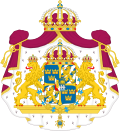


The following outline is provided as an overview of and topical guide to Sweden:
Contents
- General reference
- Geography of Sweden
- Environment of Sweden
- Regions of Sweden
- Demography of Sweden
- Government and politics of Sweden
- Branches of the State
- Foreign relations of Sweden
- Law and order in Sweden
- Military of Sweden
- Local government in Sweden
- History of Sweden
- History of Sweden, by period
- History of Sweden, by region
- History of Sweden, by subject
- Culture of Sweden
- Art in Sweden
- People of Sweden
- Religion in Sweden
- Sports in Sweden
- Economy and infrastructure of Sweden
- Education in Sweden
- See also
- References
- External links
Sweden – Scandinavian country in Northern Europe, situated between Norway and Finland. Sweden maintained a policy of neutrality in armed conflicts from 1814 until 2009, when it entered into various mutual defence treaties. Sweden joined NATO in 2024. It is a member of the European Union, but retains its own currency (the krona). Swedish icons include Sweden's quality of life, its neutrality, public health care, cars (Volvo, Saab), furniture (IKEA), blonds and pop music performers (ABBA, Roxette, and Avicii).





